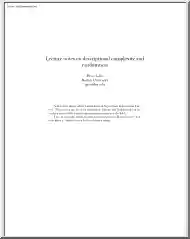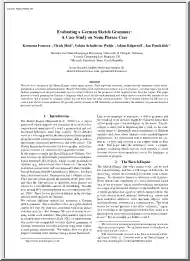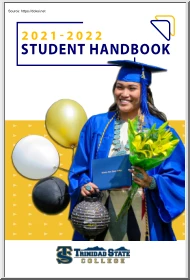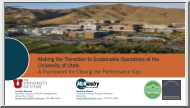A doksi online olvasásához kérlek jelentkezz be!
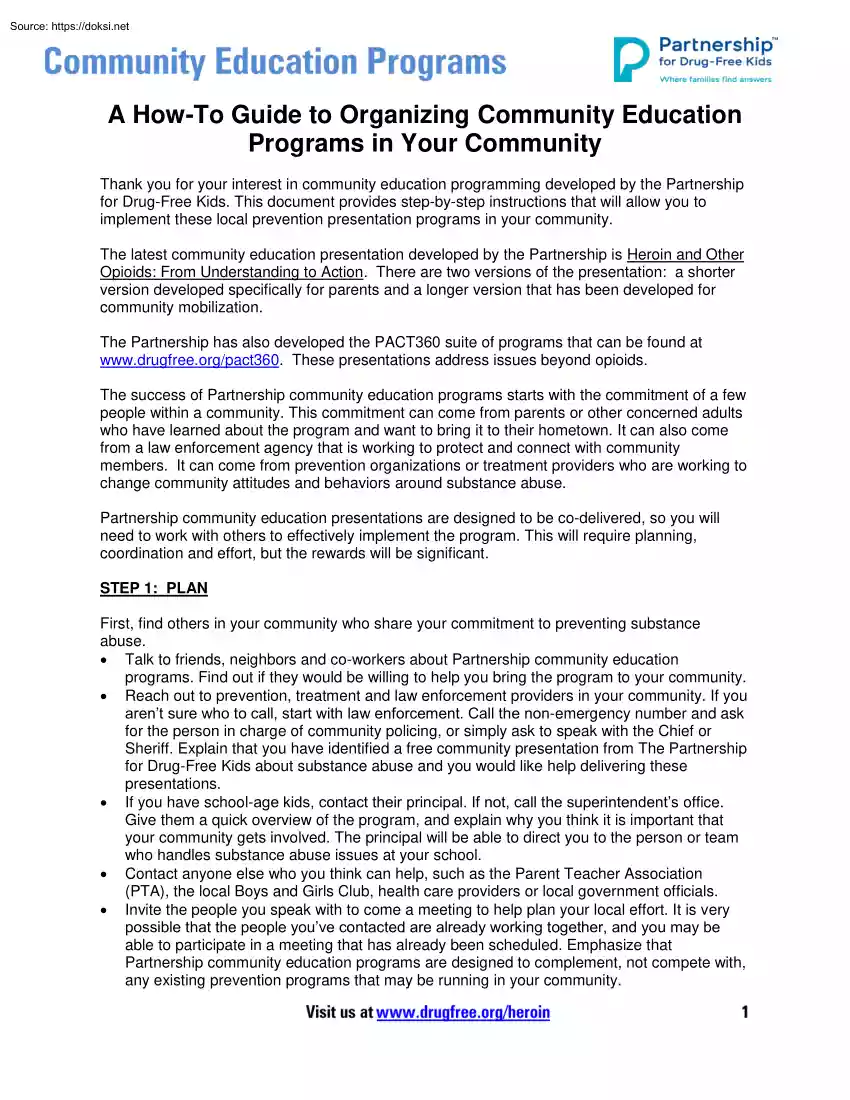
A doksi online olvasásához kérlek jelentkezz be!
Nincs még értékelés. Legyél Te az első!
Mit olvastak a többiek, ha ezzel végeztek?
Tartalmi kivonat
A How-To Guide to Organizing Community Education Programs in Your Community Thank you for your interest in community education programming developed by the Partnership for Drug-Free Kids. This document provides step-by-step instructions that will allow you to implement these local prevention presentation programs in your community. The latest community education presentation developed by the Partnership is Heroin and Other Opioids: From Understanding to Action. There are two versions of the presentation: a shorter version developed specifically for parents and a longer version that has been developed for community mobilization. The Partnership has also developed the PACT360 suite of programs that can be found at www.drugfreeorg/pact360 These presentations address issues beyond opioids The success of Partnership community education programs starts with the commitment of a few people within a community. This commitment can come from parents or other concerned adults who have learned
about the program and want to bring it to their hometown. It can also come from a law enforcement agency that is working to protect and connect with community members. It can come from prevention organizations or treatment providers who are working to change community attitudes and behaviors around substance abuse. Partnership community education presentations are designed to be co-delivered, so you will need to work with others to effectively implement the program. This will require planning, coordination and effort, but the rewards will be significant. STEP 1: PLAN First, find others in your community who share your commitment to preventing substance abuse. Talk to friends, neighbors and co-workers about Partnership community education programs. Find out if they would be willing to help you bring the program to your community Reach out to prevention, treatment and law enforcement providers in your community. If you aren’t sure who to call, start with law enforcement. Call
the non-emergency number and ask for the person in charge of community policing, or simply ask to speak with the Chief or Sheriff. Explain that you have identified a free community presentation from The Partnership for Drug-Free Kids about substance abuse and you would like help delivering these presentations. If you have school-age kids, contact their principal. If not, call the superintendent’s office Give them a quick overview of the program, and explain why you think it is important that your community gets involved. The principal will be able to direct you to the person or team who handles substance abuse issues at your school. Contact anyone else who you think can help, such as the Parent Teacher Association (PTA), the local Boys and Girls Club, health care providers or local government officials. Invite the people you speak with to come a meeting to help plan your local effort. It is very possible that the people you’ve contacted are already working together, and
you may be able to participate in a meeting that has already been scheduled. Emphasize that Partnership community education programs are designed to complement, not compete with, any existing prevention programs that may be running in your community. If you are a law enforcement professional, Partnership community education programs offer a suite of free presentations that can help parents and concerned citizens understand how they can help you protect their kids and community. If your agency is not already part of a community coalition, this program provides a way to start working with other people and community groups committed to community prevention efforts. If you work for a community coalition or prevention organization, or handle community outreach for a treatment provider, Partnership community education programs provides a suite of free, “off-the-shelf” presentations that you can localize and make your own. The presentation delivers consumer-friendly,
science-based information about risks, protective factors and effective parental intervention tips in a manner that parents can relate to. You can use your next coalition meeting as a planning meeting for the program. Once you have brought together a small group that will help you implement Partnership community education programs in your community, the next step is to answer some questions: What is your community already doing? In many communities, efforts are well underway to prevent substance abuse. You should strive to complement, rather than compete with, existing programs. Identify the organizers of these programs and be ready to reach out to them What is your scope? Where do you want to deliver your Partnership community education programs program? You can implement Partnership community education programs in one community or across a region. Many law enforcement agencies belong to task forces, and many states organize their prevention services on a regional level. Bringing
several counties and communities together is a great way to share resources and brainpower, and creates a larger pool of presenters. However, you do not want to select an area that will be too large to coordinate. Who will be your partners? Collaboration among law enforcement, prevention and treatment professionals is the cornerstone of the Partnership community education programs program. Your community may have already built good working relationships among these disciplines. If not, this program provides a way to build these ties. Try to find law enforcement, prevention and treatment professionals from each community where the program will be delivered. How many presenters will participate? You want to train enough presenters to ensure that you will have coverage for all presentation opportunities that arise. Our experience is that it’s reasonable to ask presenters to deliver two presentations per month, although surely you’ll find some who have greater availability and
interest, as well as presenters who are available less frequently. Who will coordinate the program? Coordination includes six primary tasks: Recruit presenters: This will be covered in greater detail below, but you will need to recruit a point person or small group of individuals who will maintain contact with each other and with the trained presenters of your program Train your presenters: This will also be covered in Step 3, but you will need to make sure that your presenters are experienced public speakers who are able to perform the task effectively Identify and secure audiences: Your program’s coordinator(s) will need to find audiences and secure their interest, then identify times, dates and venues when the presentations can be delivered Schedule presenters: Once you have an audience, venue, times and dates, you need to determine which presenters will also be available on those dates Deliver presentations: Ensure that the presentation takes place as
scheduled with all the necessary equipment and materials in place Maintain contact with the Partnership for Drug-Free Kids: We ask any entity that takes on this project to ensure that the presenter event report is completed after each presentation (http://fluidsurveys.com/s/HIDTA-event-report/) Each community will implement these tasks differently. You may have one point person, or a team may share these tasks. A law enforcement agency or nonprofit organization may take on this role. What resources will you need? At a minimum, you will need the following resources to deliver the Partnership community education programs presentations: A laptop computer that can run PowerPoint Sound capability with enough volume to serve your audience A projector that is compatible with the laptop computer What is your timeline? When do you want to start delivering presentations? We estimate that the planning, engagement and training phases may take up to two or three months. As this is a
volunteer effort, we encourage you to be conservative in your estimates of how long each step will take. STEP 2: GET PARTNERS ON BOARD Now it’s time to introduce the program to other organizations to secure their commitment to participate. Identify and contact the key law enforcement, prevention and treatment organizations from the areas where you plan to conduct the program. We recommend that your first meeting should be with the leaders at each organizationfor example, a Sheriff, Police Chief, Executive Director or Clinical Director. These are the people who know their organization’s resources and capabilities best and can get things done. In addition to getting their feedback on your plan, you also need to ask the tough questions. Can these organizations offer experienced, knowledgeable presenters, and/or can they assist with coordination or offer some other material support? After this meeting, rework your plans with specific tasks for each participating organization. How many
presenters will each organization provide? If they are providing materials or other support (like a laptop, projector, or covering duplication costs), document that as well. You will need to get the bosses’ approval for individuals to participate in Partnership community education programs . We recommend doing this as early as possibleyou don’t want to get to the eleventh hour, when staff is trained, and find out that you don’t have the support from the top that you’d expected. You may consider a Letter of Agreement between all parties. The decision whether to use this tool is yours. It will solidify commitments and understanding, but it may slow down the process if organizations need to extensively review the document. There is one more consideration: money. While The Partnership for Drug-Free Kids provides online learning and presentation materials for free, it is unable to offer any financial support to organizations that adopt Partnership community education programs .
You may be able to secure state and local grants or private sector sponsors to support your efforts. STEP 3: TRAIN PRESENTERS The best way to train your presenter candidates is to gather them in person to familiarize them with Partnership community education programs. Choose a venue that can accommodate the size of your group comfortably and has the necessary presentation equipment and resources. A session should last no more than a half day, but you can have more than one session if required. The Partnership for Drug-Free Kids has developed a template for these trainings, which can be obtained by e-mailing pact360@drugfree.org Here’s how a day can run: Deliver the presentations you want to use in your community: Two or three of you will need to learn the presentations and be comfortable delivering it to this audience. Introduce the website: Presenters should be familiar with all of the materials that are available on the website. Offer Presentation Skills training:
Even the most seasoned presenter can use some additional training. We’ve included a presentation skills guide online, but you may also wish to offer live skills training. You can call on a public relations firm to volunteer their time, a professor from a local college who teaches public speaking or a representative of your local Toastmasters’ Club to offer this training. You may also offer a presentation critique by splitting your presenters into teams and give them the opportunity to practice delivering a few slides each from the basic presentation. This will provide your presentation skills trainer with the ability to offer a critique, and will also allow you to identify your strongest presenters. Be certain that all presenter candidates understand how you want Partnership community education programs to be implemented locally. Presenters will need to know how they can obtain a laptop, projector and handouts, what they should do with the event report when it is completed and who
they should go to with any questions. Coordinators will need presenters’ contact information and availability. STEP 4: MARKET Marketing Partnership community education programs in your community includes increasing awareness of the program locally and promoting public presentations. The best marketing can be person-to-person. When you talk and meet with your presenters, ask them to think of groups or organizations they belong to who may be interested in a presentation. You can also ask them to take the next step and identify dates, times, and venues when their group could receive a presentation, and report this information back to the scheduler. We recommend seeking pre-gathered groups such as Rotary Clubs, PTA groups and faithbased gatherings, or local businesses who can host lunch and learn sessions. The advantage of this approach is that there are people who have already come together to receive information. The key to this approach is to identify the person who is in charge of
the agenda and convince them to provide you with time to deliver the presentation. These groups are often looking for guest speakers. Locations where Partnership community education programs presentations have been delivered include: • • • • • • • • • • Civic Organizations (Rotary, Kiwanis, Lions, etc.) School Groups (teacher in-service, Parent Teacher Organizations) Health Care (staff in-service, treatment programs) Law Enforcement (Community Watch groups, probation programs, citizen police academies, drug courts) Faith-based groups Nonprofit organizations (American Red Cross, Big Brothers Big Sisters, Camp Fire USA, etc.) Municipal facilities (fire stations, senior centers, libraries) Colleges & Universities (health classes, etc.) Workplace (lunch and learn programs, utility workers, etc.) Professional associations (realtors, Chambers of Commerce, etc.) STEP 5: DELIVER After all of the planning and training, the delivery can be the easiest step in the
process. Delivery consists of four steps: Confirm basic facts about the presentation: Who is the audience/organization, what information does the audience want, when is the presentation and where is the event located? Confirm that your Partnership community education programs presentation is on the agenda. Schedule presentations: Contact the trained presenters in your area to find a team who is available to participate in the event. Share all of the information that you have about the event with the presenters. The presenters deliver the presentation. Make sure that the presenters complete an event report and get audience evaluations completed. STEP 6: MAINTAIN CONTACT WITH THE PARTNERSHIP FOR DRUG-FREE KIDS We would very much appreciate your maintaining contact with us as you implement Partnership community education programs in your community. At The Partnership for Drug-Free Kids, we are committed to making the Partnership community education programs program a
success. Please contact us by e-mailing pact360@drugfree.org if you need more information, are facing challenges, wish to share a success story or for any other reason. Thank you! The Partnership Community Education Programs Team
about the program and want to bring it to their hometown. It can also come from a law enforcement agency that is working to protect and connect with community members. It can come from prevention organizations or treatment providers who are working to change community attitudes and behaviors around substance abuse. Partnership community education presentations are designed to be co-delivered, so you will need to work with others to effectively implement the program. This will require planning, coordination and effort, but the rewards will be significant. STEP 1: PLAN First, find others in your community who share your commitment to preventing substance abuse. Talk to friends, neighbors and co-workers about Partnership community education programs. Find out if they would be willing to help you bring the program to your community Reach out to prevention, treatment and law enforcement providers in your community. If you aren’t sure who to call, start with law enforcement. Call
the non-emergency number and ask for the person in charge of community policing, or simply ask to speak with the Chief or Sheriff. Explain that you have identified a free community presentation from The Partnership for Drug-Free Kids about substance abuse and you would like help delivering these presentations. If you have school-age kids, contact their principal. If not, call the superintendent’s office Give them a quick overview of the program, and explain why you think it is important that your community gets involved. The principal will be able to direct you to the person or team who handles substance abuse issues at your school. Contact anyone else who you think can help, such as the Parent Teacher Association (PTA), the local Boys and Girls Club, health care providers or local government officials. Invite the people you speak with to come a meeting to help plan your local effort. It is very possible that the people you’ve contacted are already working together, and
you may be able to participate in a meeting that has already been scheduled. Emphasize that Partnership community education programs are designed to complement, not compete with, any existing prevention programs that may be running in your community. If you are a law enforcement professional, Partnership community education programs offer a suite of free presentations that can help parents and concerned citizens understand how they can help you protect their kids and community. If your agency is not already part of a community coalition, this program provides a way to start working with other people and community groups committed to community prevention efforts. If you work for a community coalition or prevention organization, or handle community outreach for a treatment provider, Partnership community education programs provides a suite of free, “off-the-shelf” presentations that you can localize and make your own. The presentation delivers consumer-friendly,
science-based information about risks, protective factors and effective parental intervention tips in a manner that parents can relate to. You can use your next coalition meeting as a planning meeting for the program. Once you have brought together a small group that will help you implement Partnership community education programs in your community, the next step is to answer some questions: What is your community already doing? In many communities, efforts are well underway to prevent substance abuse. You should strive to complement, rather than compete with, existing programs. Identify the organizers of these programs and be ready to reach out to them What is your scope? Where do you want to deliver your Partnership community education programs program? You can implement Partnership community education programs in one community or across a region. Many law enforcement agencies belong to task forces, and many states organize their prevention services on a regional level. Bringing
several counties and communities together is a great way to share resources and brainpower, and creates a larger pool of presenters. However, you do not want to select an area that will be too large to coordinate. Who will be your partners? Collaboration among law enforcement, prevention and treatment professionals is the cornerstone of the Partnership community education programs program. Your community may have already built good working relationships among these disciplines. If not, this program provides a way to build these ties. Try to find law enforcement, prevention and treatment professionals from each community where the program will be delivered. How many presenters will participate? You want to train enough presenters to ensure that you will have coverage for all presentation opportunities that arise. Our experience is that it’s reasonable to ask presenters to deliver two presentations per month, although surely you’ll find some who have greater availability and
interest, as well as presenters who are available less frequently. Who will coordinate the program? Coordination includes six primary tasks: Recruit presenters: This will be covered in greater detail below, but you will need to recruit a point person or small group of individuals who will maintain contact with each other and with the trained presenters of your program Train your presenters: This will also be covered in Step 3, but you will need to make sure that your presenters are experienced public speakers who are able to perform the task effectively Identify and secure audiences: Your program’s coordinator(s) will need to find audiences and secure their interest, then identify times, dates and venues when the presentations can be delivered Schedule presenters: Once you have an audience, venue, times and dates, you need to determine which presenters will also be available on those dates Deliver presentations: Ensure that the presentation takes place as
scheduled with all the necessary equipment and materials in place Maintain contact with the Partnership for Drug-Free Kids: We ask any entity that takes on this project to ensure that the presenter event report is completed after each presentation (http://fluidsurveys.com/s/HIDTA-event-report/) Each community will implement these tasks differently. You may have one point person, or a team may share these tasks. A law enforcement agency or nonprofit organization may take on this role. What resources will you need? At a minimum, you will need the following resources to deliver the Partnership community education programs presentations: A laptop computer that can run PowerPoint Sound capability with enough volume to serve your audience A projector that is compatible with the laptop computer What is your timeline? When do you want to start delivering presentations? We estimate that the planning, engagement and training phases may take up to two or three months. As this is a
volunteer effort, we encourage you to be conservative in your estimates of how long each step will take. STEP 2: GET PARTNERS ON BOARD Now it’s time to introduce the program to other organizations to secure their commitment to participate. Identify and contact the key law enforcement, prevention and treatment organizations from the areas where you plan to conduct the program. We recommend that your first meeting should be with the leaders at each organizationfor example, a Sheriff, Police Chief, Executive Director or Clinical Director. These are the people who know their organization’s resources and capabilities best and can get things done. In addition to getting their feedback on your plan, you also need to ask the tough questions. Can these organizations offer experienced, knowledgeable presenters, and/or can they assist with coordination or offer some other material support? After this meeting, rework your plans with specific tasks for each participating organization. How many
presenters will each organization provide? If they are providing materials or other support (like a laptop, projector, or covering duplication costs), document that as well. You will need to get the bosses’ approval for individuals to participate in Partnership community education programs . We recommend doing this as early as possibleyou don’t want to get to the eleventh hour, when staff is trained, and find out that you don’t have the support from the top that you’d expected. You may consider a Letter of Agreement between all parties. The decision whether to use this tool is yours. It will solidify commitments and understanding, but it may slow down the process if organizations need to extensively review the document. There is one more consideration: money. While The Partnership for Drug-Free Kids provides online learning and presentation materials for free, it is unable to offer any financial support to organizations that adopt Partnership community education programs .
You may be able to secure state and local grants or private sector sponsors to support your efforts. STEP 3: TRAIN PRESENTERS The best way to train your presenter candidates is to gather them in person to familiarize them with Partnership community education programs. Choose a venue that can accommodate the size of your group comfortably and has the necessary presentation equipment and resources. A session should last no more than a half day, but you can have more than one session if required. The Partnership for Drug-Free Kids has developed a template for these trainings, which can be obtained by e-mailing pact360@drugfree.org Here’s how a day can run: Deliver the presentations you want to use in your community: Two or three of you will need to learn the presentations and be comfortable delivering it to this audience. Introduce the website: Presenters should be familiar with all of the materials that are available on the website. Offer Presentation Skills training:
Even the most seasoned presenter can use some additional training. We’ve included a presentation skills guide online, but you may also wish to offer live skills training. You can call on a public relations firm to volunteer their time, a professor from a local college who teaches public speaking or a representative of your local Toastmasters’ Club to offer this training. You may also offer a presentation critique by splitting your presenters into teams and give them the opportunity to practice delivering a few slides each from the basic presentation. This will provide your presentation skills trainer with the ability to offer a critique, and will also allow you to identify your strongest presenters. Be certain that all presenter candidates understand how you want Partnership community education programs to be implemented locally. Presenters will need to know how they can obtain a laptop, projector and handouts, what they should do with the event report when it is completed and who
they should go to with any questions. Coordinators will need presenters’ contact information and availability. STEP 4: MARKET Marketing Partnership community education programs in your community includes increasing awareness of the program locally and promoting public presentations. The best marketing can be person-to-person. When you talk and meet with your presenters, ask them to think of groups or organizations they belong to who may be interested in a presentation. You can also ask them to take the next step and identify dates, times, and venues when their group could receive a presentation, and report this information back to the scheduler. We recommend seeking pre-gathered groups such as Rotary Clubs, PTA groups and faithbased gatherings, or local businesses who can host lunch and learn sessions. The advantage of this approach is that there are people who have already come together to receive information. The key to this approach is to identify the person who is in charge of
the agenda and convince them to provide you with time to deliver the presentation. These groups are often looking for guest speakers. Locations where Partnership community education programs presentations have been delivered include: • • • • • • • • • • Civic Organizations (Rotary, Kiwanis, Lions, etc.) School Groups (teacher in-service, Parent Teacher Organizations) Health Care (staff in-service, treatment programs) Law Enforcement (Community Watch groups, probation programs, citizen police academies, drug courts) Faith-based groups Nonprofit organizations (American Red Cross, Big Brothers Big Sisters, Camp Fire USA, etc.) Municipal facilities (fire stations, senior centers, libraries) Colleges & Universities (health classes, etc.) Workplace (lunch and learn programs, utility workers, etc.) Professional associations (realtors, Chambers of Commerce, etc.) STEP 5: DELIVER After all of the planning and training, the delivery can be the easiest step in the
process. Delivery consists of four steps: Confirm basic facts about the presentation: Who is the audience/organization, what information does the audience want, when is the presentation and where is the event located? Confirm that your Partnership community education programs presentation is on the agenda. Schedule presentations: Contact the trained presenters in your area to find a team who is available to participate in the event. Share all of the information that you have about the event with the presenters. The presenters deliver the presentation. Make sure that the presenters complete an event report and get audience evaluations completed. STEP 6: MAINTAIN CONTACT WITH THE PARTNERSHIP FOR DRUG-FREE KIDS We would very much appreciate your maintaining contact with us as you implement Partnership community education programs in your community. At The Partnership for Drug-Free Kids, we are committed to making the Partnership community education programs program a
success. Please contact us by e-mailing pact360@drugfree.org if you need more information, are facing challenges, wish to share a success story or for any other reason. Thank you! The Partnership Community Education Programs Team
